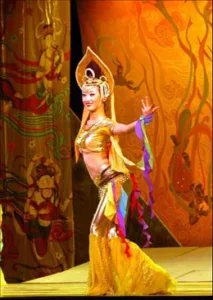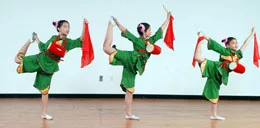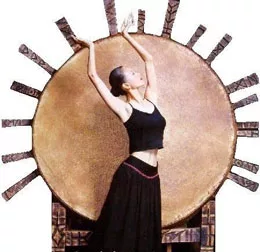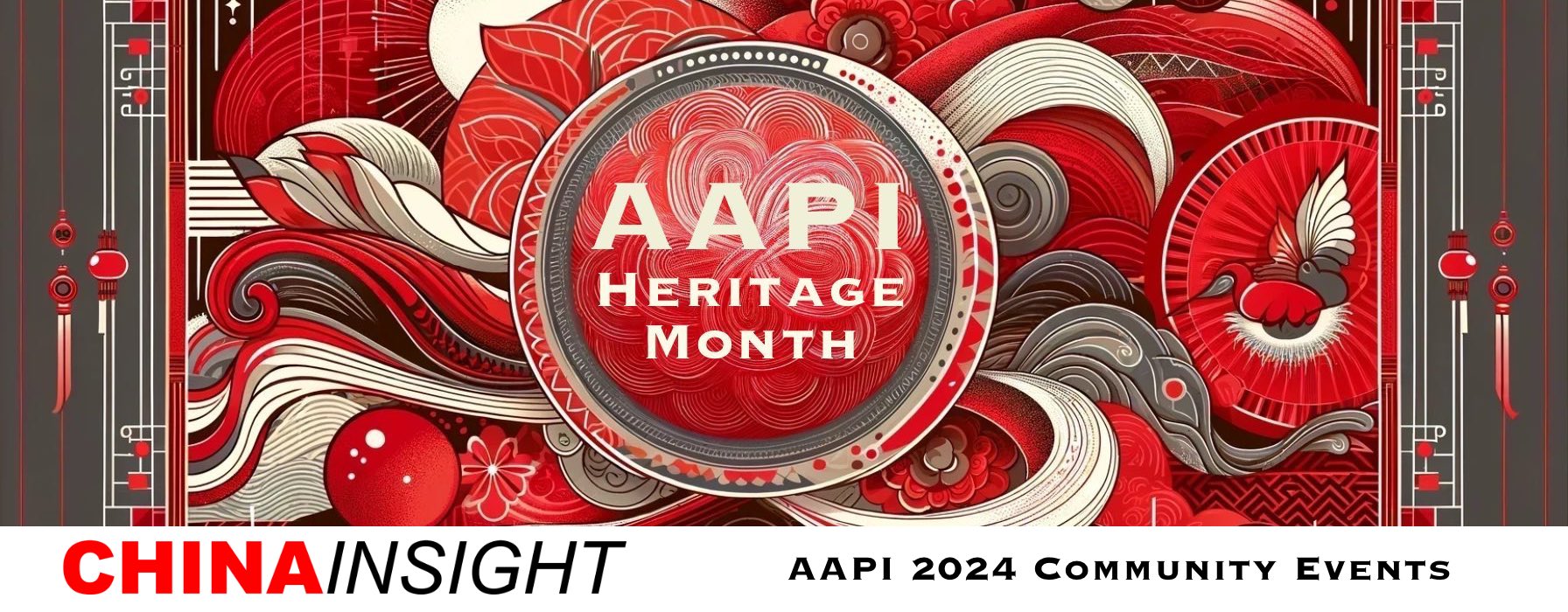By Huanru Zhang, TCCDC Artistic Director
(Originally published in the Feb 2010 issue of China Insight)
China is a multi-cultural country, with 56 different ethnicities. Each of these ethnicities has their own folk culture and dances. Chinese classical dance incorporates dance elements from these ethnic dances, Chinese operas, Chinese martial art forms and folk operas. Over time these have merged, forming the unique system that we call Chinese classical dance today. It has been refined, redeveloped and rejuvenated over thousands of years.
Attributes of Chinese Dances
The lineage of many of the dances can be traced back to the Royal Court dances of the culture of the Zhou, Tang, and Song Dynasties 5,000 years ago, where the character of the nation was expressed through dance, incorporating movements influenced by folk stories, historic figures and classic myths and legends, and expressing society’s respect for morality, compassion, loyalty, wisdom, and trustworthiness. It represents a unique system with diversity of movement, refinement of form, and richness of character and culture.

Chinese dance requires the dancers to undergo strict physical training. Actions and movements called “body techniques” need to be accurate and precise, and every action, movement and look needs to follow the preset rules. The body techniques stress beauty in various forms like “twist, tilt, round, curve, lookup, stoop, turn, roll”. Furthermore, it emphasizes that inner spirit should initiate body movements. Performers not only need to master the techniques of Chinese dance, but also perfect their moral character and willpower in order to portray the fundamental inner meaning of the Chinese culture.
It is not hard to trace an evolving line of succession from the many relics of ancient times that bore images of dancers from various dynasties. Historical evidence can be seen in unearthed tomb figurines and the Dunhuang frescoes. Signature movements in Qin and Han Dynasty dance figurines highlighted “crouching”. During the Tang Dynasty dance highlighted the curves of a female body. Chinese dance has also incorporated from traditional folk dance such as Jiaozhou Yang Ge the twist, turn and soft yet hard stomps. It has also adopted the ocean wave like, reach, block and twist steps from Ocean Yang Ge and the tilted body from Flower-drum Lantern dance famous in FengYang. From Chinese Opera, it incorporated Zi Wu look, YingYang face and the body twists unique to Chinese dance. You can also see the Dragon and Monkey styles from Chinese Martial Arts. Every element of the body techniques in Chinese dance from Curving, Turning, Twisting, Tilting and Rounding, when combined well, demonstrates the beauty of the human body. Every body part including head, neck, chest, waist, hips, shoulder, elbow, wrist, arm, palm to knee, ankle and foot all have their own specific requirements for movement.
ShenYun, roughly translated as body rhythm, is the most important Chinese classical dance performance technique. It focuses on “Shape, spirit, strength and pattern” as the four basic elements of body rhythm and form. Shape refers to the external action, gesture and movement connected with the movement line. Spirit means internal senses and mind playing the role of leading the thinking and determining movements. Strength is the force, guiding the severity, urgency, strong vs. weak, long vs. short, rigid vs. flexible part of the movement. Pattern indicates the execution by defined dance standards. These four elements integrated together yield an internal and external unity where the heart can be combined with the mind; the mind can be combined with energy; energy combined with the strength and strength combined with shapes.
People often say that “the eyes are windows into the soul”. While the eyes of “gather, put, condensate and close” does not mean that the eye movement itself, but rather is subject to the domination of internal psychological connections and the rhythm of internal spirit. “Before the movement takes shape, there has to be spirit first; when the shape has vanished the spirit lingers”. The Chinese dance theory combined with the dance elements of body techniques formed a high degree of unity, harmonization, composition and dance aesthetic theory with unique Chinese characteristics.

Rhythm is very prominent in Chinese classical dance and has an inseparable connection with Chinese music. Compared with Western music which has more regular uniform tones, Chinese music is heavier in pulse-like rhythm, generally expressed as flexible combination of rhythm and the characteristics of points and lines. Reflected in the rhythm, mostly like point (stretch – in time), or cut points (in time – stretch), or two stretch the middle of rush, or two catch in the middle stretch, or the tight playing then slow, or slow to tight playing and so on. Therefore, the formation of the internal rhythm of movement, such as soft vs. tough, fast move vs. sudden freeze, slow vs. rush, put vs. collect, breath in and out, cadence, combined points and lines, etc., results in the dynamic law of Chinese music’s particular characteristics and sense of rhythms.
Artistic Elements of Chinese Dances
Chinese dance originated from people’s life. It also stays very close to daily life. It combines entertainment with performing art. It is one piece of great treasure of the Chinese history and culture.
China is a geographically wide-spread country. The uniqueness of Mother Nature in the living environment, the religious and the history of each ethnic group has cultivated their specific culture. In turn, their unique culture has shown significant impact on their different forms of art, including their dances. We could almost say their dances are the showcases of each ethnic group. Different costumes, different props, and different expression of feelings are apparent in their dances. Different instruments and different languages are clear as well. All these features make Chinese dance very colorful and entertaining. However, they also make the dance techniques very delicate and challenging. Thus, teaching Chinese dance and dancer training is a very specialized area because dancers are not only trained in body movements, dancing techniques, but also need to be trained to understand the different cultural backgrounds and stories behind each dance. Dancers also need to tune to different style of music, some red hot, some very expressive and emotional.
For example, in Han ethnic dance, there is beautiful choreography combined with some interesting props that come from people’s daily life, such as handkerchiefs, hats, umbrellas, chopsticks and plates. The step work sometimes requires power and firmness, while at other times require elegance. On top of that, the dancers always show special techniques using their props, most of the times are very acrobatic such as continuously spinning of the handkerchiefs or sticks, balancing hats, plates, or umbrellas using their hands or heads while they dance. The styles are significantly different from one region to another. Dance in North Eastern China is very muscular, the energetic red ribbon and drum dance is found in Shaanxi Province (Central China), the feminine fan dance is in Southern China, and the very festive lantern dance is in Yunnan (South Eastern China). This list can go on and be endless.

If we expand to different ethnic groups, the Chinese dances become more splendorous. In the Tibetan dance, male dancers dance with special ox tail costumes that are decorated with jingling bells. Female dancers hold special-made ox skin drums. The bells and the drums create strong rhythm to guide the dancers’ footsteps. In Mongolian dance, dancers shake their shoulders and arms vigorously by following the music they create themselves using chopsticks hitting on different parts of their costume. The Uyghur style dance shows very elegant movement of the eyes, hands and neck. The Korean dance in North Eastern China features in dancers carrying the hourglass shaped drums in front of their body. By hitting the sticks on different parts of the drums, the dancers use their body to create very musical movements at the same time, sometimes slow, others fast; sometimes joyful, others sad.
In conclusion, Chinese classical dance has formed its own system, which has a strong national identity, emphasizing its nation’s aesthetic character and aesthetic norms, with its own way of artistic expression. It is a dance system that can be replaced by no other.


